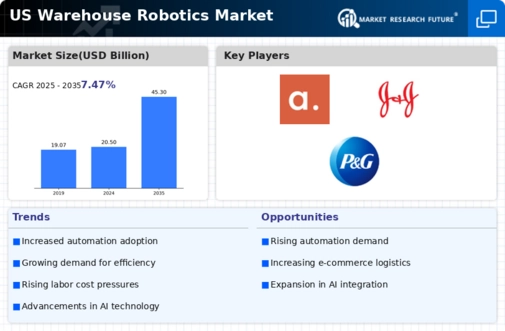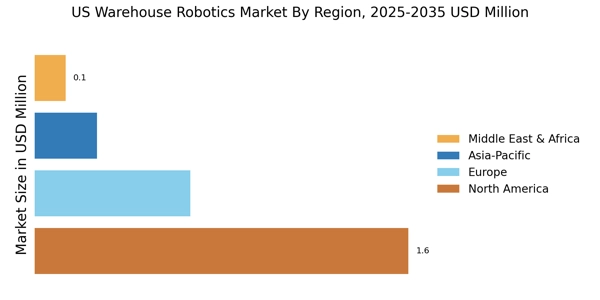The US Warehouse Robotics Market is currently characterized by a dynamic competitive landscape, driven by rapid technological advancements and increasing demand for automation in logistics. Key players such as Amazon Robotics (US), GreyOrange (US), and Locus Robotics (US) are at the forefront, each adopting distinct strategies to enhance their market positioning. Amazon Robotics (US) continues to leverage its vast resources to innovate in robotic solutions, focusing on integrating AI and machine learning to optimize warehouse operations. Meanwhile, GreyOrange (US) emphasizes flexibility in its robotic systems, allowing for seamless integration with existing warehouse infrastructures, which appears to resonate well with clients seeking to modernize without extensive overhauls. Locus Robotics (US) is also notable for its collaborative robots, which enhance human-robot interaction, thereby improving efficiency and safety in warehouse environments. Collectively, these strategies contribute to a competitive environment that is increasingly focused on technological innovation and operational efficiency.
In terms of business tactics, companies are increasingly localizing manufacturing and optimizing supply chains to enhance responsiveness and reduce costs. The market structure is moderately fragmented, with several players vying for market share, yet the influence of major companies is substantial. This competitive structure allows for a diverse range of solutions, catering to various customer needs while fostering innovation through competition.
In August 2025, Amazon Robotics (US) announced the launch of its latest autonomous mobile robot, designed to improve inventory management and reduce operational costs. This strategic move is significant as it not only reinforces Amazon's commitment to automation but also positions the company to capture a larger share of the growing e-commerce logistics sector. The introduction of this advanced technology is likely to enhance operational efficiencies across its extensive network of fulfillment centers.
In September 2025, GreyOrange (US) unveiled a new software platform that integrates AI-driven analytics with its robotic systems, aimed at optimizing warehouse workflows. This development is crucial as it reflects a broader trend towards data-driven decision-making in warehouse operations. By enhancing the intelligence of its robotic solutions, GreyOrange is likely to improve customer satisfaction and operational performance, thereby solidifying its competitive edge.
In October 2025, Locus Robotics (US) entered into a strategic partnership with a leading logistics provider to expand its deployment of collaborative robots in North American warehouses. This partnership is indicative of a growing trend towards collaboration in the industry, as companies seek to leverage each other's strengths to enhance service offerings. Such alliances may prove essential in navigating the complexities of modern supply chains and meeting the increasing demands for efficiency and speed.
As of October 2025, the competitive trends in the US Warehouse Robotics Market are heavily influenced by digitalization, sustainability, and the integration of AI technologies. Strategic alliances are becoming increasingly prevalent, shaping the landscape as companies collaborate to enhance their technological capabilities. Looking ahead, it appears that competitive differentiation will increasingly pivot from price-based strategies to a focus on innovation, technological advancement, and supply chain reliability, suggesting a transformative shift in how companies compete in this evolving market.

















Leave a Comment